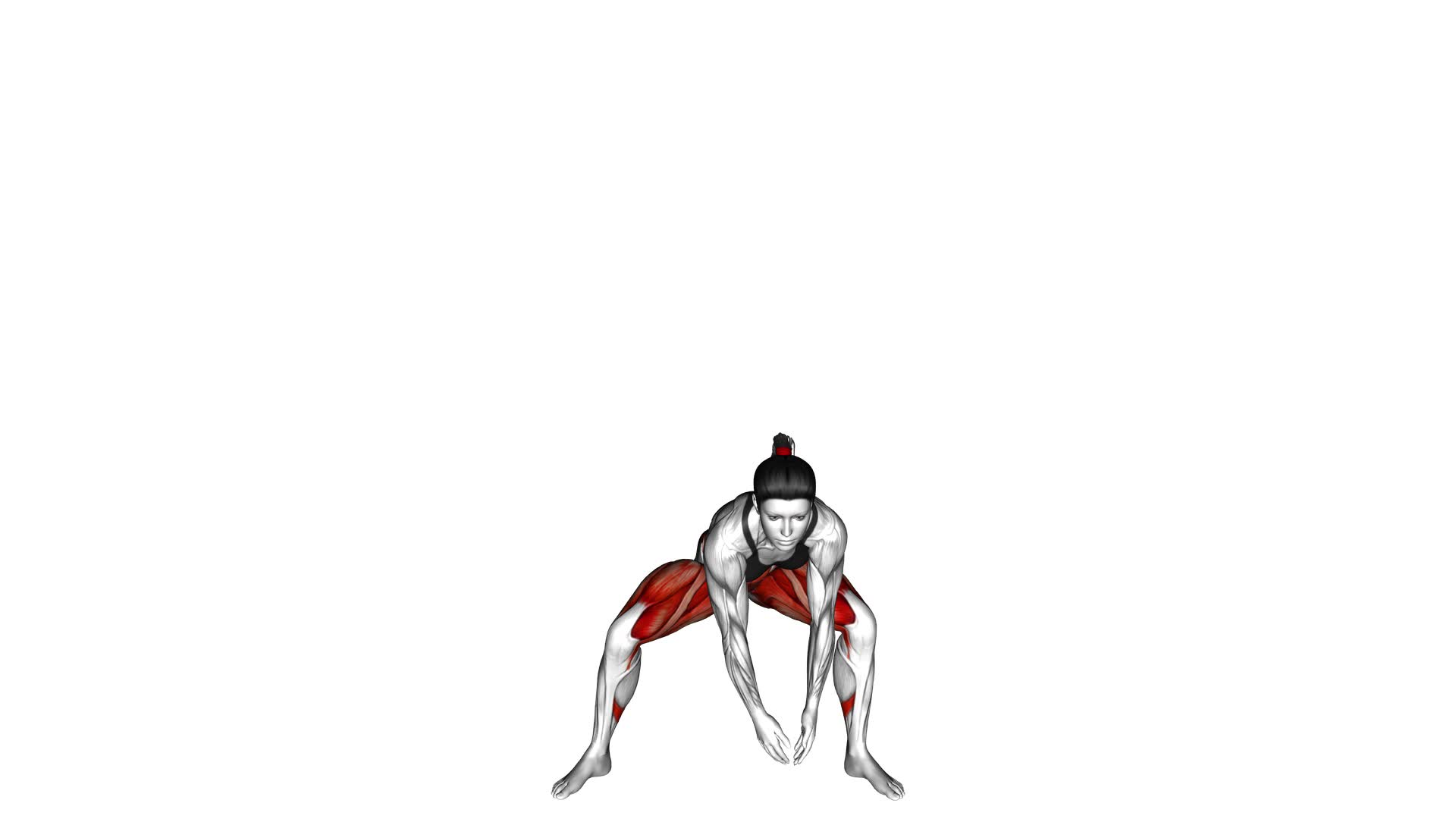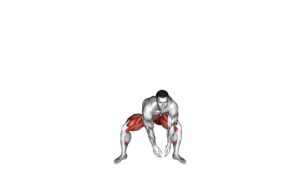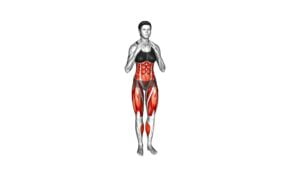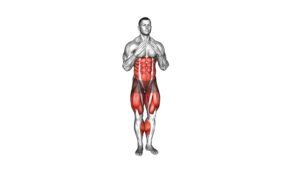Side Squat Touchdown (female) – Video Exercise Guide & Tips

Are you looking for a challenging exercise that targets your lower body? Look no further than the Side Squat Touchdown.
Watch This Exercise Video
This video exercise guide will show you the proper form and technique to perform this move effectively. Plus, you'll find helpful tips to avoid common mistakes and maximize your results.
Get ready to tone your legs and improve your balance with this dynamic exercise.
Let's dive in and get moving!
Key Takeaways
- Increased flexibility
- Engages multiple muscle groups
- Tones and strengthens inner and outer thighs
- Improves balance and stability
Benefits of the Side Squat Touchdown
The side squat touchdown offers a variety of benefits for women looking to improve their lower body strength and stability. One of the main benefits of this exercise is increased flexibility. By performing the side squat touchdown, you engage multiple muscle groups, including the quadriceps, hamstrings, glutes, and hip adductors. As you lower into the squat position, you stretch and lengthen these muscles, promoting greater flexibility over time.
Additionally, the side squat touchdown activates the muscles in your lower body, leading to improved muscle activation. This exercise targets the inner and outer thighs, helping to tone and strengthen these areas. It also engages the core muscles, including the abdominals and obliques, as you stabilize your body during the movement. This increased muscle activation not only enhances your overall strength but also helps to improve your balance and stability.
Incorporating the side squat touchdown into your workout routine can have a positive impact on your lower body strength, stability, flexibility, and muscle activation. It's a versatile exercise that can be modified to suit your fitness level and goals. Remember to maintain proper form throughout the movement and gradually increase the intensity as you become more comfortable.
Proper Form and Technique
To ensure proper form and technique for the side squat touchdown, it's important for you to maintain a stable and balanced position throughout the exercise. Here are three important points to keep in mind:
- Common misconceptions: One common misconception is that you need to squat deeply to get the most out of this exercise. However, going too low can put excessive strain on your knees and compromise your form. Instead, focus on maintaining a comfortable squat depth that allows you to keep proper form and alignment.
- Importance of proper alignment: Proper alignment is crucial to prevent injuries and maximize the effectiveness of the side squat touchdown. Make sure your feet are hip-width apart, toes pointing slightly outward. As you lower into the squat, keep your knees aligned with your toes and your chest lifted. Engage your core muscles to maintain stability throughout the movement.
- Engage your glutes and inner thighs: The side squat touchdown targets the glutes and inner thighs, so it's important to actively engage these muscles during the exercise. As you lower into the squat, push your hips back and down, focusing on squeezing your glutes and pressing through your inner thighs to return to the starting position.
Modifications and Progressions
For modifications and progressions, try incorporating variations of the side squat touchdown to challenge and improve your lower body strength and stability. One modification you can try is using a resistance band around your thighs. This will add extra resistance and help engage your glutes and outer thighs more effectively.
Another modification is to perform the side squat touchdown on an unstable surface, such as a balance board or Bosu ball. This will require additional core stability and enhance proprioception.
To further progress the exercise, you can try the advanced variations. One option is to add a jump at the end of each side squat touchdown. This will increase the intensity and elevate your heart rate.
Another advanced variation is to hold dumbbells or kettlebells at your sides while performing the exercise. This will provide an additional challenge to your upper body and further engage your core.
Incorporating modifications and advanced variations into your side squat touchdown routine will help you continuously challenge your muscles and prevent plateauing. These variations will also help you build strength and stability in different planes of motion.
Now, let's move on to the next section and learn about common mistakes to avoid during the side squat touchdown.
Common Mistakes to Avoid
When performing the side squat touchdown, it's important to avoid common mistakes that can hinder your progress and increase the risk of injury. Here are three key mistakes to avoid:
- Rushing through the exercise: Taking your time and performing each movement with control is crucial to avoid injuries. Rushing through the side squat touchdown can lead to improper form and strain on your muscles and joints. Remember to maintain a slow and controlled pace throughout the exercise.
- Neglecting proper breathing technique: Breathing plays a vital role in any exercise routine, including the side squat touchdown. Failing to breathe properly can lead to dizziness, lightheadedness, and decreased performance. Make sure to inhale deeply through your nose before starting the movement and exhale forcefully through your mouth as you lower into the squat position.
- Incorrect knee alignment: One common mistake is allowing your knees to cave inward during the side squat touchdown. This puts unnecessary stress on your knee joints and increases the risk of injury. To avoid this, focus on keeping your knees in line with your toes throughout the exercise. Engage your glutes and quads to maintain proper alignment and stability.
Tips for Maximizing Results
To maximize your results with the side squat touchdown, consistently incorporate this exercise into your workout routine.
In addition to regular exercise, there are also important nutrition tips and recovery strategies that can help you maximize your results.
Firstly, when it comes to nutrition, it's essential to fuel your body properly. Make sure you're consuming enough calories to support your workouts, as well as a balanced diet rich in lean proteins, whole grains, fruits, and vegetables. This will provide your body with the nutrients it needs to build and repair muscles, resulting in better overall performance and results.
Secondly, prioritize recovery to optimize your results. Give your body enough time to rest and recover between workouts to prevent overtraining and reduce the risk of injury. Incorporate stretching and foam rolling into your routine to improve flexibility and reduce muscle soreness. Additionally, prioritize sleep to allow your body to repair and regenerate.
Frequently Asked Questions
How Many Calories Does the Side Squat Touchdown Burn?
The side squat touchdown is a great exercise for burning calories. It targets your legs, glutes, and core, resulting in an effective full-body workout.
While the exact number of calories burned varies depending on factors like weight and intensity, you can expect to burn around 150-250 calories in a 30-minute session.
If you're a beginner, start with modified versions of the exercise, such as reducing the depth of the squat or using a chair for support.
Can the Side Squat Touchdown Help Improve Balance?
The side squat touchdown is a versatile exercise that can help improve balance and stability.
By engaging the muscles in your legs, hips, and core, this exercise challenges your body to maintain control and stability while moving laterally.
Additionally, there are variations of the side squat touchdown that can further challenge and improve your balance, such as adding weights or incorporating a balance board.
Incorporating this exercise into your routine can be a beneficial way to work on your balance and stability.
Is It Safe to Perform the Side Squat Touchdown if I Have Knee or Hip Issues?
If you have knee or hip issues, it's important to consider your safety when performing the side squat touchdown exercise. It may not be the best choice for you, as it involves lateral movements that can put strain on those areas.
However, there are modifications you can make to reduce the impact on your knees and hips.
It's always wise to consult with a healthcare professional before attempting any exercise that could exacerbate knee pain.
Can the Side Squat Touchdown Be Incorporated Into a Lower Body Workout Routine?
Yes, incorporating side squat variations like the side squat touchdown into your lower body workout routine can be beneficial.
Lateral movements help target different muscles in the lower body, including the glutes, quads, and inner thighs. This can enhance overall lower body strength and stability.
Additionally, side squat variations can improve balance and coordination.
Remember to listen to your body and modify or avoid any exercises that may aggravate knee or hip issues.
How Often Should the Side Squat Touchdown Be Performed for Optimal Results?
To get the most out of the side squat touchdown exercise, it's important to consider its frequency and effectiveness.
When determining how often to perform this exercise for optimal results, you should aim for a balanced approach. Incorporate the side squat touchdown into your lower body workout routine two to three times a week.
This frequency will allow your muscles to recover while still reaping the benefits of this effective exercise. Remember to always listen to your body and adjust accordingly.
Conclusion
In conclusion, the side squat touchdown is a beneficial exercise that targets the lower body and improves stability and balance. By maintaining proper form and technique, you can maximize the effectiveness of this exercise.
Modifications and progressions can be implemented to suit different fitness levels. Avoiding common mistakes and following the tips provided will help you achieve optimal results.
Incorporating the side squat touchdown into your workout routine can contribute to overall strength and mobility.

Author
Years ago, the spark of my life’s passion ignited in my mind the moment I stepped into the local gym for the first time. The inaugural bead of perspiration, the initial endeavor, the very first surge of endorphins, and a sense of pride that washed over me post-workout marked the beginning of my deep-seated interest in strength sports, fitness, and sports nutrition. This very curiosity blossomed rapidly into a profound fascination, propelling me to earn a Master’s degree in Physical Education from the Academy of Physical Education in Krakow, followed by a Sports Manager diploma from the Jagiellonian University. My journey of growth led me to gain more specialized qualifications, such as being a certified personal trainer with a focus on sports dietetics, a lifeguard, and an instructor for wellness and corrective gymnastics. Theoretical knowledge paired seamlessly with practical experience, reinforcing my belief that the transformation of individuals under my guidance was also a reflection of my personal growth. This belief holds true even today. Each day, I strive to push the boundaries and explore new realms. These realms gently elevate me to greater heights. The unique combination of passion for my field and the continuous quest for growth fuels my drive to break new ground.



